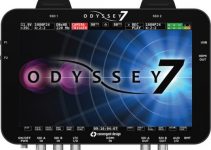Alongside the release of their overhauled MacBook Pro lineup a month ago, Apple has also announced another enticing partnership project this time with Blackmagic Design regarding the release of a dedicated eGPU specifically designed to complement the latest line of supported OS-based devices. In a nutshell, the Blackmagic eGPU features a built-in Radeon Pro 580 GPU with 8GB memory, 2 x Thunderbolt 3 ports, HDMI 2.0, 85W of charging power and 4 x USB 3.1 connections. And yes, it’s the first eGPU to support Thunderbolt 3 displays.
While the device has clearly sparked interest among professionals, its $699 price tag has shocked many potential customers leaving them wondering whether the Blackmagic eGPU would serve as a better value over a more customizable eGPU like the Razer Core X. The topic was recently covered by Jeff Benjamin of 9to5Mac, who compares the performance of the Blackmagic eGPU to the Razer Core X in the video below.
Unlike the Blackmagic eGPU, the Razer Core X allows you to add any macOS supported graphics card that best suits your creative needs. For the sake of this comparison, the video showed AMD’s highest-end graphics card, the Vega 64, being used with the enclosure. Each card was tested with both a 13 and 15-inch 2018 MacBook Pro using several games and benchmarking applications.
Throughout the tests, one trend quickly became quite evident: the Razer Core X eGPU ultimately resulted in better performance. This is large-in-part thanks to the fact that with the Core X, you’re able to choose your own GPU. With the Vega 64 graphics, the Core X outperformed the Blackmagic eGPU in all tests, including Unigine Valley and Heaven, as well as the LuxMark OpenCL.
Despite the lack of customization, there are two reasons as to why you might want to invest in the Blackmagic eGPU. For starters, the design of the enclosure is not only eye-catching, but it’s built to run silent, producing significantly less noise compared to the Razer Core X. Therefore, if you need an eGPU for use in a studio environment, the Blackmagic eGPU may be the better option for your needs.
Secondly, if you happen to have an LG UltraFine 5K display, you’ll be able to provide power and a graphics connection to the monitor using only one cable which can be a real no-brainer for some users. On the other hand, if this your sole reason for investing in the Blackmagic eGPU, there wouldn’t be much-added value to your purchase.
By analyzing the results from the benchmarks, it becomes clear that the Razer Core X has the better value in terms of price-to-performance. Although purchasing a Core X and separate graphics card may be more expensive than Blackmagic’s offering, the ability to choose from a list of supported graphics cards allows you to upgrade your hardware as newer models become available down the road.
Plus, this option prevents your investment from becoming obsolete relatively quickly, something that unfortunately doesn’t apply to the Blackmagic eGPU regardless of its slick design and seamless performance.
[source: 9to5Mac]
Disclaimer: As an Amazon Associate partner and participant in B&H and Adorama Affiliate programmes, we earn a small comission from each purchase made through the affiliate links listed above at no additional cost to you.



